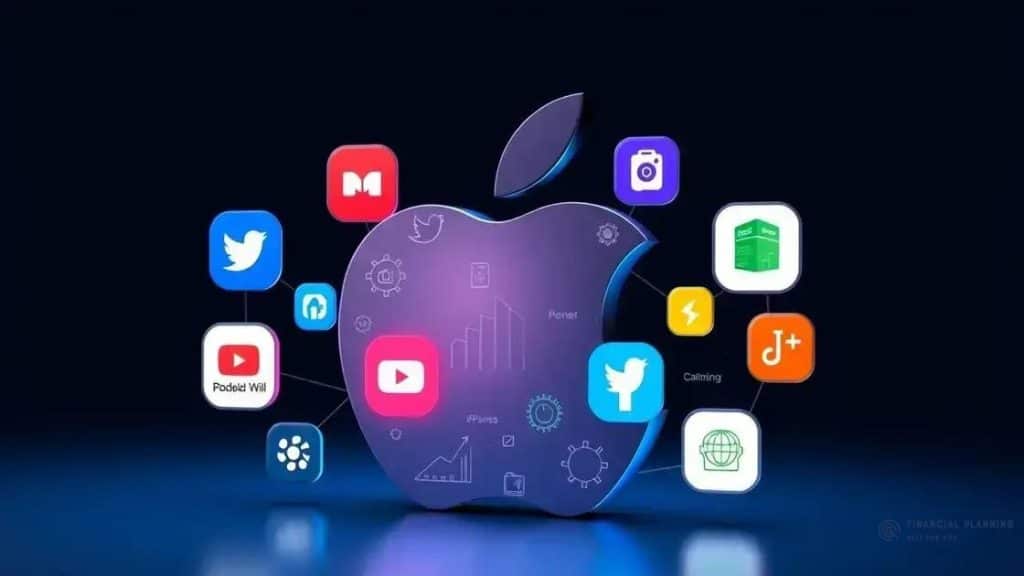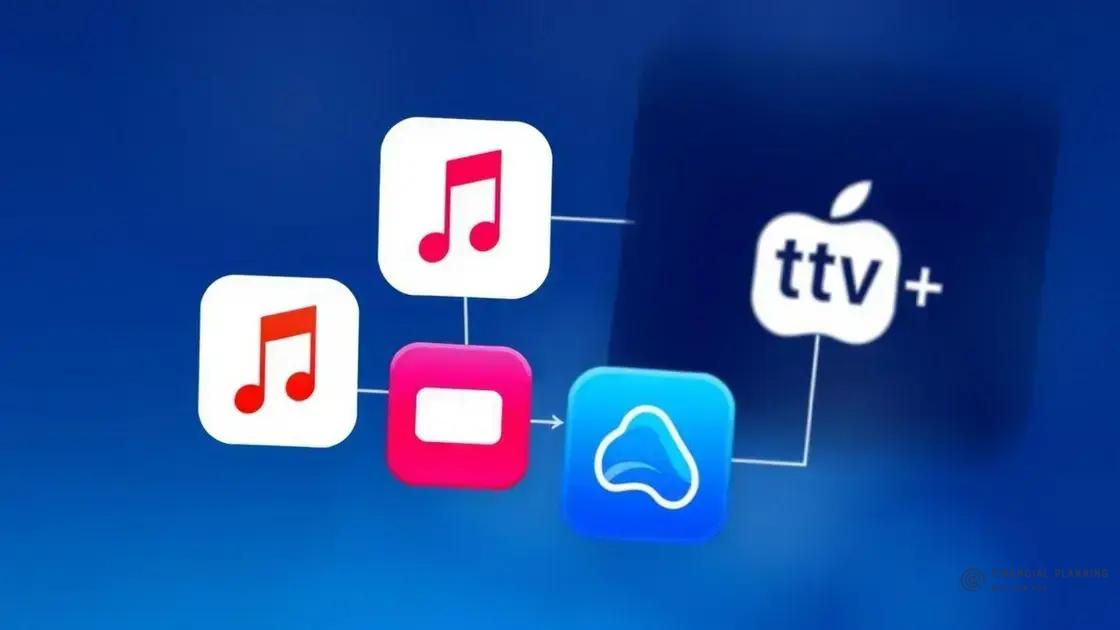Apple’s $26.34 billion services revenue in Q1 2025

Apple’s services revenue reached $26.34 billion in Q1 2025, driven by innovations, customer engagement, and a diverse offering of digital services, positioning the company for continued growth in the competitive market.
Apple’s $26.34 billion services revenue in Q1 2025 is a testament to its thriving ecosystem. Have you ever wondered how this impacts its growth strategy and market positioning? Let’s dive deeper.
Understanding Apple’s service revenue model
Understanding Apple’s service revenue model is crucial for grasping how the company generates income beyond hardware sales. Apple’s strategy revolves around creating a seamless ecosystem that encourages users to engage with its services.
Key Components of the Revenue Model
The revenue model includes various segments that contribute significantly to the overall income. These segments encompass services such as:
- App Store: A marketplace where developers sell apps and users purchase them.
- Apple Music: A popular streaming service that offers millions of songs and exclusive content.
- iCloud: Cloud storage that syncs user data across devices.
- Subscription Services: An array of offerings such as Apple TV+, Apple Arcade, and more.
This diversified approach helps Apple maintain a strong revenue stream even during periods where hardware sales might fluctuate. The engagement with services often makes customers more loyal to Apple products.
Impact of the Services Segment
The services segment has shown impressive growth, contributing billions to Apple’s total revenue. This success can be attributed to:
- Customer Loyalty: Many customers continue using Apple products consistently.
- Exclusive Content: Apple offers unique services and content that are appealing to consumers.
- Ease of Use: Apple’s services are designed to integrate tightly with its devices, encouraging usage.
As users engage more with Apple services, the overall lifetime value of each customer increases. This trend underscores the importance of not only attracting new customers but also retaining existing ones through compelling services.
In conclusion, understanding Apple’s service revenue model provides valuable insights into its business strategy. By focusing on customer experience and loyalty through its services, Apple continues to thrive in a competitive market.
Key drivers behind the $26.34 billion success

Exploring the key drivers behind the $26.34 billion success of Apple’s services reveals the innovative strategies that fuel its growth. Various factors contribute to this impressive figure, making it vital to understand what’s behind the numbers.
Innovation in Services
One of the strongest drivers is Apple’s commitment to innovation. The company continuously improves its services, ensuring they remain relevant and attractive. This includes:
- New Feature Releases: Regular updates and new features keep users engaged.
- User-Friendly Design: Apple services are known for their easy navigation and appealing interfaces.
- Exclusive Content: Original content for Apple TV+ and music adds value for subscribers.
These innovations not only attract new customers but also retain existing ones, fostering long-term relationships. Beyond innovation, another critical aspect is user engagement.
User Engagement and Experience
Apple understands the importance of user engagement for increasing service usage. A seamless experience across devices encourages customers to explore multiple services. This is seen in:
- Cross-Platform Functionality: Users can easily switch between devices while using Apple services.
- Personalized Recommendations: Tailored suggestions enhance user satisfaction.
- Loyalty Programs: Engaging users with rewards for continued subscriptions increases retention.
When customers feel valued and catered to, they are more likely to continue using Apple services. Additionally, the integration of services into daily life cannot be overlooked.
Integration of Services into Daily Life
Apple has successfully integrated its services, making them part of everyday activities. This seamless integration is beneficial for Apple’s service revenue. For instance, using Apple Music while exercising or iCloud for storing important photos highlights how services become essential.
Furthermore, strong marketing and brand loyalty play significant roles in driving success. Apple consistently promotes its services, reinforcing their value through effective advertising and a well-established brand image.
Ultimately, understanding these drivers is key to appreciating how Apple achieves such remarkable revenue through its services.
Comparative analysis with previous quarters
Conducting a comparative analysis with previous quarters helps us understand the growth and trends of Apple’s services revenue. By examining the data from earlier periods, it becomes clear how Apple has evolved in its service offerings.
Quarterly Revenue Growth
Apple has consistently shown impressive revenue growth in its services segment over the past few quarters. For instance, comparing the Q1 2025 revenue of $26.34 billion to earlier quarters unveils significant trends. Consider the numbers:
- Q1 2024: $20 billion
- Q1 2023: $18 billion
- Q1 2022: $15 billion
This steady increase showcases how Apple has successfully expanded its services portfolio and attracted more subscribers over time. Each quarter has built on the last, reflecting a robust growth trajectory.
Factors Influencing Changes
Several factors contribute to the fluctuations in quarterly revenue. Firstly, the launch of new services or features often results in a spike in revenue. For example, the introduction of Apple TV+ and enhancements to Apple Music can lead to increased subscriptions.
Another factor is seasonal demand. Around the holiday season, for instance, services tend to see a surge. Promotions and bundled offers also play a role in drawing in more customers.
Finally, changes in the competitive landscape affect how Apple performs against other service providers. Keeping an eye on competitors provides valuable insights into Apple’s market position.
Overall Performance Trends
As we analyze the data, it’s evident that Apple’s services are not just a bonus but a vital part of their business model. The positive trends indicate that customers value their offerings.
Focusing on innovation and customer engagement helps Apple maintain a leading edge. Understanding these patterns can inform expectations for future quarters, setting the stage for continued growth.
Impact of Apple services on overall business

The impact of Apple services on the overall business is profound and multifaceted. As Apple continues to expand its services, it significantly influences its revenue streams and customer loyalty.
Revenue Contribution
Apple services contribute a substantial portion to the company’s overall revenue. For instance, in Q1 2025, services accounted for $26.34 billion, reflecting a steady increase year over year. This growth in revenue allows Apple to reinvest in its technology and further enhance the user experience.
- Service Diversity: The range of services offered—from Apple Music to iCloud—ensures varied revenue sources.
- Increased Customer Retention: Engaging customers with services like Apple TV+ and exclusive content builds long-term loyalty.
- Market Expansion: Successful services open new markets and attract different demographics.
As the business landscape evolves, Apple’s ability to innovate and offer valuable services becomes crucial in maintaining its competitive edge. This capability leads to increased market share and revenue stability.
Customer Loyalty and Brand Strength
Apple’s services also enhance customer loyalty and brand strength. When users engage with multiple services, their attachment to the Apple ecosystem deepens.
Customers who use services like iCloud and Apple Music are less likely to switch to competitors. This loyalty translates into more predictable revenue and a stronger market position.
Engagement strategies such as personalized recommendations and customer support create a user experience that keeps customers returning. As users see the value in these services, they become advocates for the brand, further promoting Apple.
Long-term Business Strategy
The integration of services is not just a current strategy; it’s a fundamental part of Apple’s long-term vision. By offering a suite of interconnected services, Apple positions itself as an indispensable part of daily life for many consumers. Each service enhances the value of others, creating a cohesive experience that encourages user retention. This comprehensive strategy aims for continuous growth and adaptation in a competitive market.
Ultimately, the impact of Apple services on the overall business is clear: they are a vital engine for revenue, customer loyalty, and brand strength.
Future projections for Apple’s services revenue
Future projections for Apple’s services revenue show promising growth. Analysts predict that the services segment will continue to expand as Apple enhances its offerings and attracts more customers.
Market Trends
Current market trends suggest a strong demand for digital services. As more consumers shift to online platforms, companies like Apple stand to benefit. The rise in subscriptions and digital content consumption is particularly noteworthy. Analysts expect this trend to drive Apple’s services revenue even higher.
- Increased Subscriber Base: More people are joining platforms like Apple Music and Apple TV+.
- Diverse Service Offerings: Expanding services such as health and fitness can tap into new markets.
- Global Expansion: Apple is focusing on international markets, where digital service demand is increasing.
As Apple adapts to these trends, it maintains a strong position to capture a larger share of the market.
Innovations on the Horizon
Innovations play a vital role in future projections for revenue. Apple consistently invests in new technologies and features that enhance user experience. For example, introducing more personalized content recommendations will likely keep users engaged. Additionally, expanding the ecosystem around services can encourage cross-service utilization.
Users are drawn to comprehensive offerings that work seamlessly across devices, and Apple excels in this area. New integrations with Apple’s hardware, such as the iPhone and Apple Watch, will also strengthen service use.
Competitor Landscape
The competitive landscape will influence future projections. As other tech companies also evolve their service offerings, Apple must stay ahead. Monitoring competitors is essential to understand changing consumer preferences. Maintaining high-quality user experiences is crucial to retaining existing subscribers.
Forecasting suggests that Apple’s services could potentially reach over $40 billion in revenue within the next few years, driven by strong demand and innovative enhancements across its service lineup.
FAQ – Frequently Asked Questions about Apple’s Services Revenue
What are the main factors driving Apple’s services revenue growth?
Key factors include innovation in services, increased user engagement, and a diverse portfolio of offerings.
How does Apple maintain customer loyalty?
Apple retains customer loyalty through seamless integration of services, personalized experiences, and a strong ecosystem.
What future projections are there for Apple services revenue?
Analysts project that Apple’s services revenue could exceed $40 billion in the coming years, driven by increasing demand for digital services.
What impact do competitors have on Apple’s services growth?
Competitors influence Apple to continually innovate and enhance user experiences to retain market share.





